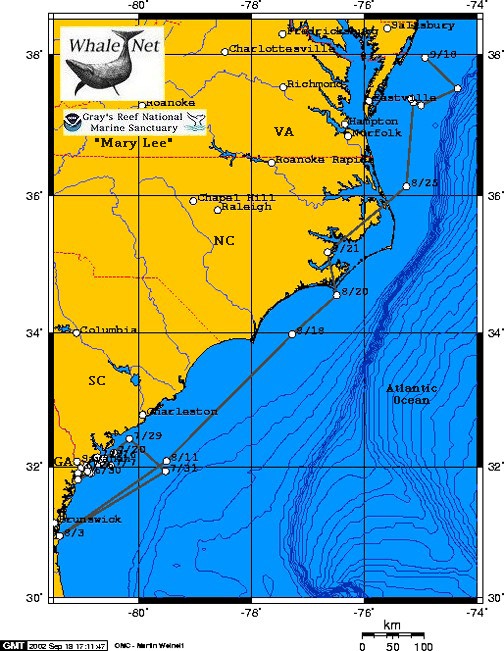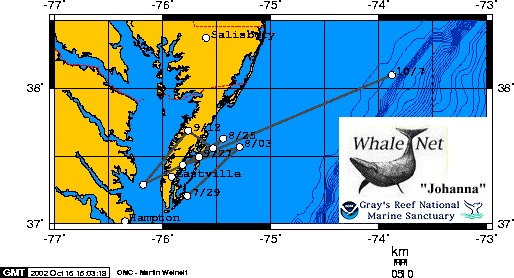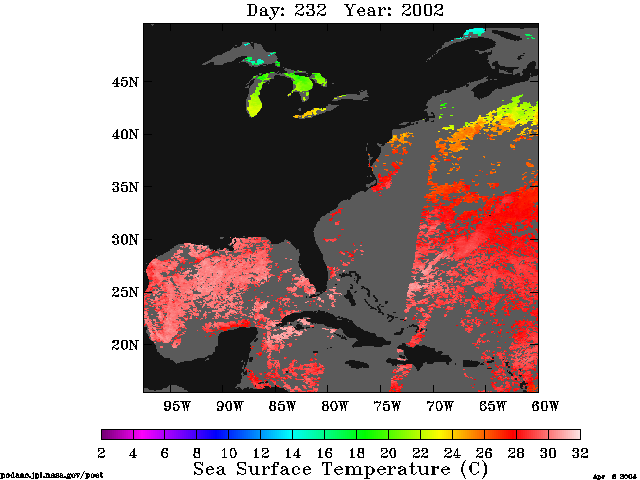|
Research Paper
 Satellite
tracking for Mary Lee and Joanna began on June 26, 2002. Both turtles began
their migration on the east coast in Savannah, Georgia where they were
released by NOAA sponsored Grey’s Reef National Marine Sanctuary, and moved
in a northern direction. The beginning latitude and longitude for Joanna
was 32.000 N and 80.928 W. The beginning latitude and longitude for Mary
Lee was 31.981 N and 81.022 W. Both turtles followed the same path for most
of the way. Mary Lee took a detour South towards Brunswick, Georgia before
heading north again. The data used to determine the migration patterns of
the turtles are the differences in sea surface temperature. Since data was
collected over a time period of three months, the mean temperature was taken
of each month to compare the data. The mean temperature for July was
28.7743 degrees Celsius for Mary lee and 26.6137 for Joanna. The mean
temperature for August was 26.3031 degrees Celsius for Mary Lee and 25.8085
for Joanna. The mean temperature for September was 23.6943 degrees Celsius
for Mary Lee and 23.9016 for Joanna. The CERSER program at Elizabeth City
State University began tracking satellite data on July 11, 2002. That was
sixteen days after the tracking of Joanna and Mary Lee began, so data
collection began on July 19, 2002, which was the first day that data from
CERSER corresponded to the data from WhaleNet. The comparison for the two
turtles ended on September 19, 2002. This was the last recorded data that
the turtles had in common. The following graph reflects the data collected
in the CERSER lab. Satellite
tracking for Mary Lee and Joanna began on June 26, 2002. Both turtles began
their migration on the east coast in Savannah, Georgia where they were
released by NOAA sponsored Grey’s Reef National Marine Sanctuary, and moved
in a northern direction. The beginning latitude and longitude for Joanna
was 32.000 N and 80.928 W. The beginning latitude and longitude for Mary
Lee was 31.981 N and 81.022 W. Both turtles followed the same path for most
of the way. Mary Lee took a detour South towards Brunswick, Georgia before
heading north again. The data used to determine the migration patterns of
the turtles are the differences in sea surface temperature. Since data was
collected over a time period of three months, the mean temperature was taken
of each month to compare the data. The mean temperature for July was
28.7743 degrees Celsius for Mary lee and 26.6137 for Joanna. The mean
temperature for August was 26.3031 degrees Celsius for Mary Lee and 25.8085
for Joanna. The mean temperature for September was 23.6943 degrees Celsius
for Mary Lee and 23.9016 for Joanna. The CERSER program at Elizabeth City
State University began tracking satellite data on July 11, 2002. That was
sixteen days after the tracking of Joanna and Mary Lee began, so data
collection began on July 19, 2002, which was the first day that data from
CERSER corresponded to the data from WhaleNet. The comparison for the two
turtles ended on September 19, 2002. This was the last recorded data that
the turtles had in common. The following graph reflects the data collected
in the CERSER lab.
Mary Lee
(Figure 4) was tracked up until September 20, 2002 which only showed her
migration north.

Joanna was
tracked until February 4, 2003 which showed both her migration north and
then south. Joanna’s ending latitude and longitude was 34.008 N and 76.606
W. 
Sea surface
temperature data from Physical Oceanographic DAAC was used to validate our
sea surface temperature findings.
The turtles remained close
to the shoreline throughout their migration. For that reason, loggerhead
turtles carve to feed in coastal bays and estuaries; in addition to, shallow
water along the continental shelves. Both turtles were spotted on land near
the end of August. Loggerhead turtles nest during the months of May through
August. Most females nest at least twice during the mating season; some may
nest up to ten times in a season. So although there is no proof that the
turtles were nesting, it is reasonable to believe that is what they were
doing.


|